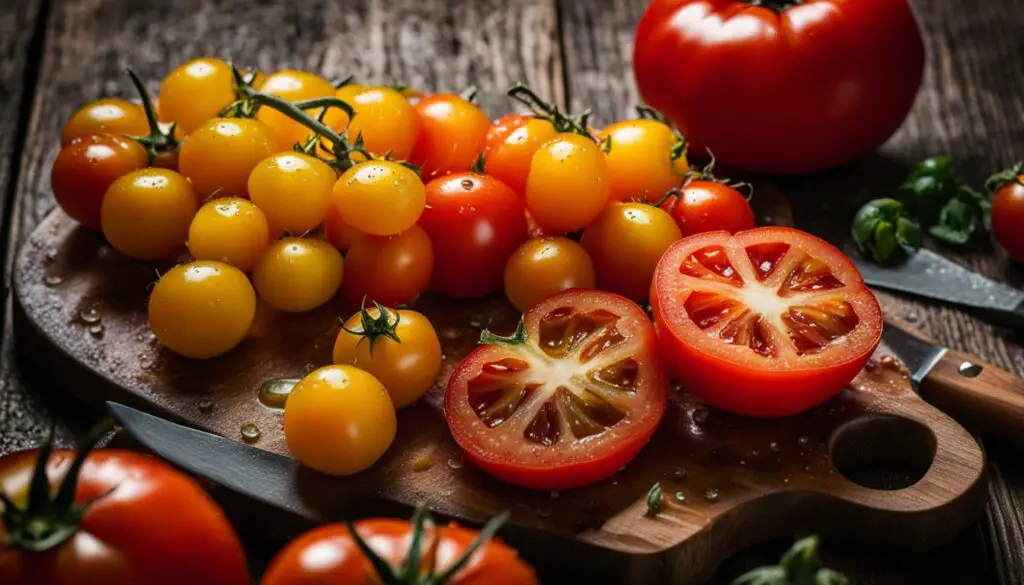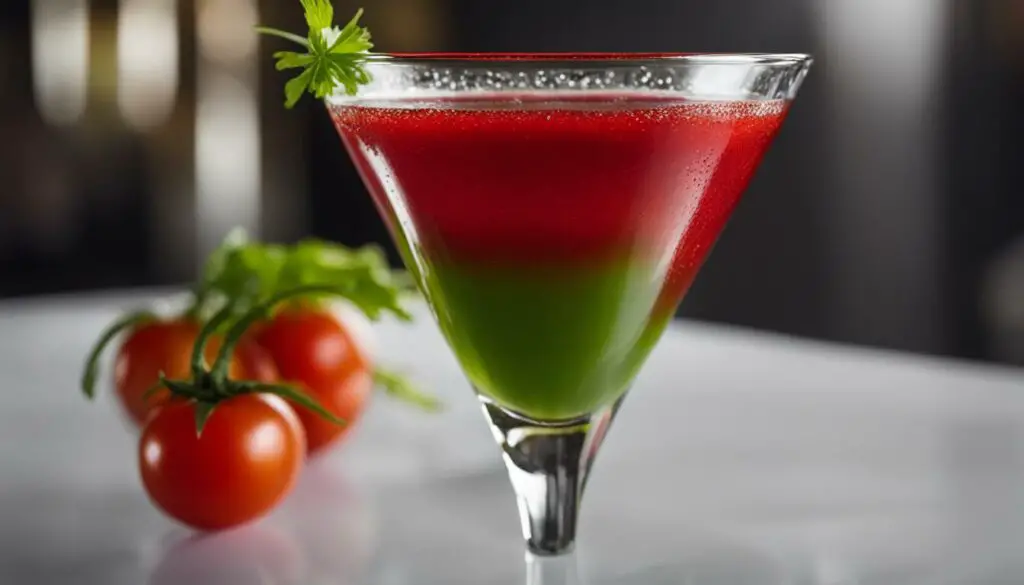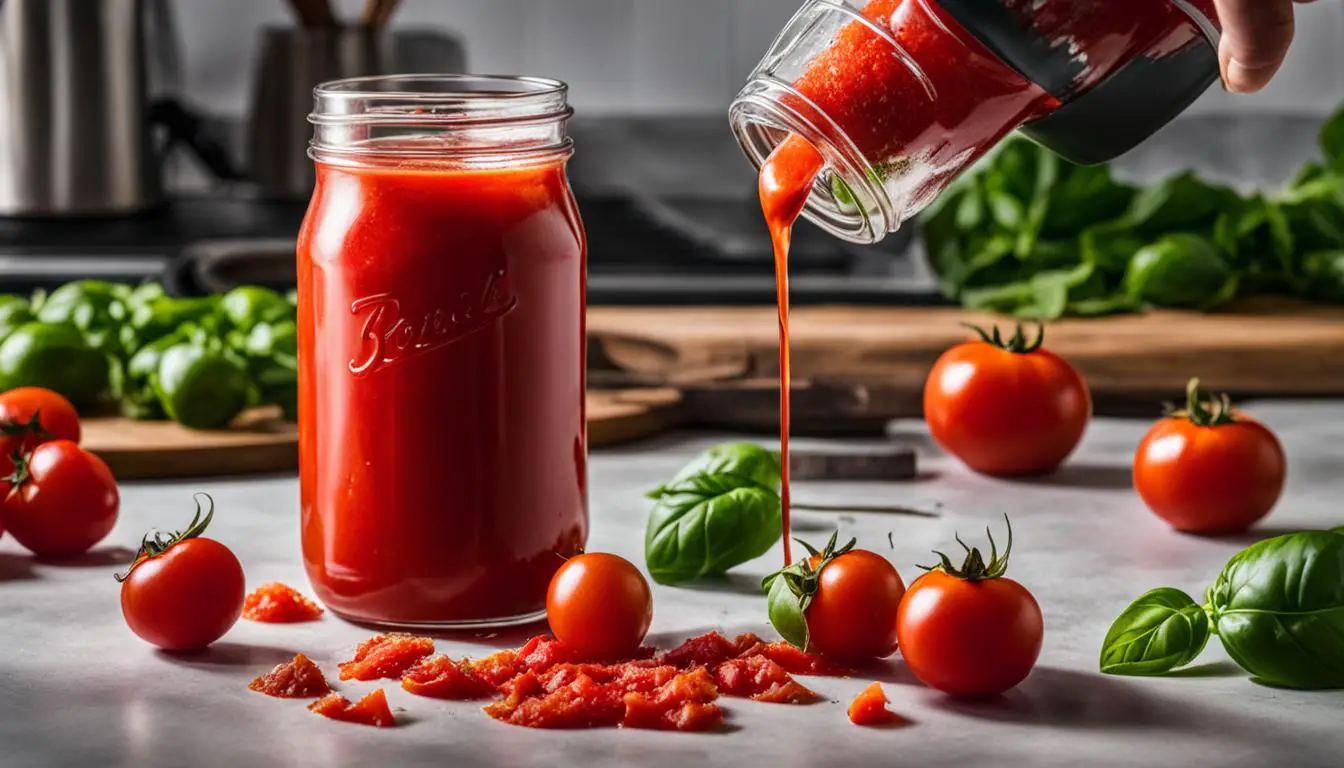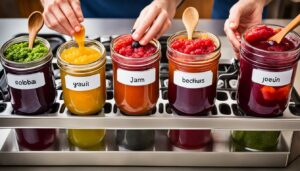Making and canning tomato juice is a great way to preserve the abundance of ripe tomatoes from your garden. This easy recipe uses a variety of tomatoes to create a flavorful and fresh juice. You can use any tomato variety, but larger tomatoes like heirloom varieties are preferred for their higher juice content. It’s important to avoid using primarily low acid tomato varieties for canning, as the natural acid in tomatoes helps to safely preserve the juice. Instead, freeze the juice if using mostly low acid tomatoes. The process involves washing the tomatoes, removing any bad spots, and cutting them into small chunks. The tomatoes are cooked until soft and mashed to release their juices. Finally, the juice is strained to remove the seeds and skins, and then bottled with lemon juice for acidity before canning.
Contents
- 1 Ingredients for Can Tomato Juice Recipe
- 2 How to Make Can Tomato Juice
- 3 How to Store Can Tomato Juice
- 4 Tomato Juice Recipes: A Versatile Ingredient for Delicious Dishes
- 5 Tips for Making Can Tomato Juice
- 6 The Benefits of Homemade Tomato Juice
- 7 Freezing vs. Canning Tomato Juice
- 8 Safety Considerations for Canning Tomato Juice
- 9 How to Make a Virgin Mary Drink
- 10 Conclusion
- 11 FAQ
- 11.1 What tomatoes should I use to make can tomato juice?
- 11.2 Can I use low acid tomato varieties for canning tomato juice?
- 11.3 What ingredients do I need to make can tomato juice?
- 11.4 How do I make can tomato juice?
- 11.5 How should I store can tomato juice?
- 11.6 What are some uses for homemade tomato juice?
- 11.7 What are some tips for making can tomato juice?
- 11.8 What are the benefits of homemade tomato juice?
- 11.9 Should I freeze or can tomato juice?
- 11.10 What safety considerations should I keep in mind when canning tomato juice?
- 11.11 How do I make a Virgin Mary drink with tomato juice?
- 12 Source Links
Key Takeaways:
- Making and canning your own tomato juice is a great way to preserve ripe tomatoes.
- Use a variety of tomatoes, preferably larger ones like heirloom varieties.
- Avoid using mostly low acid tomatoes for canning.
- Wash, remove bad spots, and cut tomatoes into small chunks.
- Cook the tomatoes until soft, mash them, and strain the juice before canning.
Ingredients for Can Tomato Juice Recipe

When it comes to making delicious and healthy tomato juice, the key is in the ingredients. Here are the essential components you’ll need to create the perfect can tomato juice recipe:
- Tomatoes: Use ripe, flavorful tomatoes as the main ingredient. Red tomatoes on the vine or plum tomatoes are great options.
- Salt and pepper: Season the juice to taste with salt and pepper.
- Optional spices: Enhance the flavor of your tomato juice by adding spices like paprika, onion powder, celery salt, cayenne, chili powder, or hot sauce.
- Lemon juice or citric acid: If you plan on canning the tomato juice, you’ll need to add bottled lemon juice or citric acid to increase its acidity. This is necessary for safe preservation.
By using fresh tomatoes and adding just the right amount of seasoning, you can create a healthy and flavorful tomato juice that can be enjoyed on its own or used as a base for other recipes.
Table: Tomato Juice Ingredients
| Ingredients | Quantity |
|---|---|
| Tomatoes | Ripe, flavorful tomatoes (any variety) |
| Salt | To taste |
| Pepper | To taste |
| Optional spices | To taste (paprika, onion powder, celery salt, cayenne, chili powder, or hot sauce) |
| Lemon juice or citric acid | As needed for canning |
“Fresh tomatoes and just the right blend of seasonings are the secret to a delicious, homemade tomato juice recipe.” – Tomato Lover
How to Make Can Tomato Juice

Making your own tomato juice from scratch is a simple and rewarding process. With just a few steps, you can create a flavorful and nutritious juice that can be enjoyed on its own or used in various recipes.
To start, gather fresh ripe tomatoes. Choose any variety you prefer, but sweeter tomatoes like red tomatoes on the vine or plum tomatoes are recommended for their rich flavor. Wash the tomatoes and remove any bad spots. Cut them into small chunks to speed up the cooking process.
In a large pot, heat a portion of the tomato chunks and mash them to release their juices. Stir frequently to prevent burning. Once the first batch starts to boil, add the remaining tomatoes and bring the pot back to a boil. Simmer for a few minutes until the tomatoes are easily smashed.
Next, strain the cooked tomatoes through a food mill or strainer to remove the seeds and skins. This will give your tomato juice a smoother consistency. Return the strained juice to the pot and bring it back to a boil. If you plan on canning the juice, add the appropriate amount of lemon juice to each jar before filling them with hot tomato juice. If not canning, let the juice cool before storing it in the refrigerator or freezer.
By following these easy steps, you can make delicious tomato juice from scratch. Whether you want to enjoy it as a refreshing drink or use it in your favorite recipes, homemade tomato juice adds a burst of freshness and flavor to any dish.
How to Store Can Tomato Juice
After canning your homemade tomato juice, it’s important to store it properly to maintain its freshness and quality. Here are some tips on how to store can tomato juice:
- Allow the jars to sit in the hot water with the burner turned off for 5 minutes after canning.
- Carefully remove the jars from the canner and place them on a thick towel to cool for 24 hours.
- Test each lid to ensure proper sealing. Any unsealed jars should be refrigerated and consumed within 2 weeks.
- Store the properly sealed jars in a cool, dark place to maintain their flavor and nutritional value.
- Label each jar with the processing date for easy identification.
It’s normal to see some separation of liquid in homemade tomato juice, so don’t be alarmed if you notice it in the jars. As long as the jars are properly sealed and the lemon juice was added for acidity during canning, the tomato juice is safe to consume.
If you don’t plan on canning the tomato juice, you have other storage options. After cooling, you can store the juice in a pitcher or jars in the refrigerator. It’s best to consume refrigerated tomato juice within 3 days to ensure its freshness. Alternatively, you can freeze the juice in freezer-safe containers. Remember to leave some headspace for expansion, label the containers, and store them in the freezer for up to a year. Freezing is a great option if you want to enjoy your homemade tomato juice for an extended period.
Properly Stored Tomato Juice Shelf Life
| Storage Method | Shelf Life |
|---|---|
| Canned Tomato Juice | Up to 1 year in a cool, dark place |
| Refrigerated Tomato Juice | Up to 3 days |
| Frozen Tomato Juice | Up to 1 year |
By following these storage guidelines, you can enjoy your homemade tomato juice for an extended period and have it readily available whenever you need it. Whether you choose to can, refrigerate, or freeze the juice, it’s important to store it properly to maintain its flavor and nutritional benefits.
Tomato Juice Recipes: A Versatile Ingredient for Delicious Dishes

Homemade tomato juice is a versatile ingredient that can elevate the flavor of a wide range of dishes. Whether you’re looking to create a hearty vegetable soup, a tangy homemade spaghetti sauce, or a refreshing tomato-based cocktail, using homemade tomato juice adds a fresh and vibrant taste.
One popular way to use homemade tomato juice is as a base for soups and stews. Its rich and savory flavor pairs well with other vegetables and herbs, creating a delicious and comforting dish. You can also experiment with different spices and seasonings to customize the taste to your liking.
Another great way to use homemade tomato juice is in sauces. By combining it with tomato sauce or tomato puree, you can create a flavorful and robust spaghetti sauce that will impress your family and friends. Add Italian spices like basil, oregano, and garlic to enhance the taste even further.
Table: Delicious Recipes Using Homemade Tomato Juice
| Recipe | Description |
|---|---|
| Homemade Vegetable Soup | A hearty and nutritious soup made with fresh vegetables and flavorful homemade tomato juice. |
| Homemade Spaghetti Sauce | A delicious and aromatic sauce made with homemade tomato juice, tomato sauce, and Italian spices. |
| Virgin Mary Cocktail | A non-alcoholic version of the classic Bloody Mary drink, made with homemade tomato juice, Worcestershire sauce, and spices. |
“Using homemade tomato juice in your recipes adds a burst of fresh flavor that cannot be replicated by store-bought alternatives. It’s a simple and delicious way to enhance the taste of your favorite dishes!”
In addition to soups, sauces, and cocktails, homemade tomato juice can also be enjoyed on its own as a healthy and refreshing drink. Simply chill it in the refrigerator and serve it over ice for a cool and revitalizing beverage. You can also add a touch of heat with some hot sauce or spices to create your own version of the classic V-8 juice.
With its versatility and delicious taste, homemade tomato juice is a fantastic ingredient to have on hand in your kitchen. Experiment with different recipes and flavors to find your favorite way to use this flavorful and nutritious juice. Get creative and explore the endless possibilities that homemade tomato juice offers!
Tips for Making Can Tomato Juice
When it comes to making can tomato juice, there are several tips that can help ensure a successful outcome. These tips will not only enhance the flavor of your homemade tomato juice but also ensure that it is safe for consumption and properly preserved. Here are some valuable tips to keep in mind:
Choose Ripe Tomatoes
Start with ripe tomatoes for the best flavor and juice content. Ripe tomatoes are sweeter and will yield a more flavorful juice. Look for tomatoes that are firm but slightly soft to the touch, with vibrant color and a pleasant aroma.
Properly Prepare the Tomatoes
Before using the tomatoes, make sure to wash them thoroughly and remove any bad spots. Cutting the tomatoes into small chunks will help them cook faster and release their juices more efficiently. Be sure to remove the seeds and skins after cooking to achieve a smoother consistency.
Add Lemon Juice for Acidity
If you are canning your tomato juice, it’s important to add the appropriate amount of lemon juice to each jar. This helps increase the acidity of the juice, preventing bacterial growth and ensuring safe preservation. Follow the recommended guidelines for lemon juice measurements based on jar size.
Follow Canning Guidelines
If you choose to can your tomato juice, it’s crucial to follow the proper canning guidelines to ensure safety. This includes sterilizing your jars, lids, and utensils, as well as processing the jars at the correct temperature and time based on your altitude. Following these guidelines will help prevent spoilage and ensure that your tomato juice stays fresh.
By following these tips, you can make delicious and safe can tomato juice at home. Whether you choose to enjoy it fresh or preserve it for later use, homemade tomato juice is a versatile and flavorful addition to your kitchen. Experiment with different tomato varieties and seasonings to create your own signature recipe. Start making your own can tomato juice today!
The Benefits of Homemade Tomato Juice
Homemade tomato juice offers numerous advantages over store-bought alternatives. By making your own tomato juice at home, you have complete control over the quality and freshness of the ingredients used. This means you can choose ripe tomatoes from your garden or select high-quality ones to ensure a flavorful and nutritious juice. The use of fresh ingredients also allows you to customize the flavor according to your preference, whether you prefer a sweeter or spicier taste.
Another benefit of homemade tomato juice is its cost-effectiveness. By making large batches and storing them for future use, you can save money compared to constantly buying store-bought tomato juice. Plus, you can avoid any added preservatives or artificial ingredients commonly found in commercial products.
In addition to being cost-effective, homemade tomato juice offers a range of health benefits. Tomatoes are rich in vitamins A, C, and K, as well as antioxidants like lycopene, which has been associated with various health benefits including reduced risk of certain diseases. By enjoying homemade tomato juice, you can reap the nutritional benefits of fresh tomatoes while enjoying a refreshing and delicious beverage.
| Advantages of Homemade Tomato Juice |
|---|
| Control over quality and freshness |
| Customizable flavor |
| Cost-effective compared to store-bought |
| Avoidance of added preservatives and artificial ingredients |
| Rich in vitamins, antioxidants, and potential health benefits |
Enjoy the benefits of homemade tomato juice by following a simple recipe and experimenting with different tomato varieties and seasonings. Whether you use it as a base for soups and sauces, or enjoy it as a refreshing drink, homemade tomato juice is sure to add a burst of flavor and nutrition to your culinary creations.
Freezing vs. Canning Tomato Juice
When it comes to preserving tomato juice, you have two main options: freezing or canning. Both methods have their advantages and considerations, so let’s take a closer look at each.
Freezing Tomato Juice
Freezing tomato juice is a simple and convenient method. After cooking and straining the tomato juice, let it cool and pour it into freezer-safe containers or bags. Be sure to leave some headspace for expansion. Label the containers and store them in the freezer for up to a year. Freezing preserves the flavor and nutrients of the tomato juice, making it a great option if you want a quick and easy way to enjoy homemade tomato juice.
Canning Tomato Juice
Canning tomato juice requires more preparation and equipment, but it offers longer shelf life and convenient storage. After cooking and straining the juice, add the appropriate amount of bottled lemon juice for acidity. Fill sterilized jars with the hot tomato juice, leaving some headspace. Wipe the rim clean, seal the jars, and process them in a water bath or pressure canner according to altitude and processing time guidelines. Properly sealed jars of canned tomato juice can be stored for up to a year in a cool, dark place.
Choosing the Right Method
The method you choose for preserving tomato juice depends on your preferences and resources. Freezing is a great option if you value simplicity and quick access to your homemade juice. Canning requires more time and equipment but offers the advantage of long-term storage and convenience. Consider factors such as available freezer space, desired shelf life, and personal preference when deciding between freezing and canning. Whichever method you choose, you’ll be able to enjoy the delicious taste of homemade tomato juice whenever you want!
Safety Considerations for Canning Tomato Juice
When it comes to canning tomato juice, it’s essential to prioritize safety to ensure the preservation of your homemade juice. By following proper procedures, you can avoid bacterial growth and enjoy your tomato juice with peace of mind. Here are some important safety considerations to keep in mind:
Choose Ripe Tomatoes
Start with fresh, ripe tomatoes for the best flavor and quality. Ripe tomatoes have a higher acidity level, which contributes to the safety of the canned juice. Avoid using unripe or overripe tomatoes, as they may not have the necessary acidity.
Add Lemon Juice or Citric Acid
To ensure adequate acidity in your canned tomato juice, it’s crucial to add lemon juice or citric acid. This helps prevent the growth of harmful bacteria and provides the necessary pH level for safe canning. Follow the recipe guidelines for the appropriate amount of lemon juice or citric acid based on the jar size.
Properly Sterilize Jars and Equipment
Before starting the canning process, make sure to thoroughly clean and sterilize your jars, lids, and utensils. This helps eliminate any potential contaminants that could compromise the safety and shelf life of your tomato juice. Follow the recommended sterilization methods to ensure proper sanitation.
Follow Altitude and Processing Time Guidelines
Altitude can affect the processing time required for safe canning. It’s important to follow altitude guidelines specific to your location to ensure that the tomato juice reaches the necessary temperature for preservation. Incorrect processing times can lead to under-processing and increase the risk of bacterial growth.
| Safety Considerations for Canning Tomato Juice |
|---|
| Choose Ripe Tomatoes |
| Start with fresh, ripe tomatoes for the best flavor and quality. Ripe tomatoes have a higher acidity level, which contributes to the safety of the canned juice. Avoid using unripe or overripe tomatoes, as they may not have the necessary acidity. |
| Add Lemon Juice or Citric Acid |
| To ensure adequate acidity in your canned tomato juice, it’s crucial to add lemon juice or citric acid. This helps prevent the growth of harmful bacteria and provides the necessary pH level for safe canning. Follow the recipe guidelines for the appropriate amount of lemon juice or citric acid based on the jar size. |
| Properly Sterilize Jars and Equipment |
| Before starting the canning process, make sure to thoroughly clean and sterilize your jars, lids, and utensils. This helps eliminate any potential contaminants that could compromise the safety and shelf life of your tomato juice. Follow the recommended sterilization methods to ensure proper sanitation. |
| Follow Altitude and Processing Time Guidelines |
| Altitude can affect the processing time required for safe canning. It’s important to follow altitude guidelines specific to your location to ensure that the tomato juice reaches the necessary temperature for preservation. Incorrect processing times can lead to under-processing and increase the risk of bacterial growth. |
How to Make a Virgin Mary Drink
One popular use for tomato juice is in the Virgin Mary drink, also known as a non-alcoholic Bloody Mary. To make a Virgin Mary, combine tomato juice with Worcestershire sauce, Tabasco sauce, celery salt, black pepper, and lemon juice. Add vodka for a traditional Bloody Mary. Mix all the ingredients together and serve over ice. Garnish with a celery stalk, lemon wedge, or olives for extra flavor. Adjust the seasonings to your preference and enjoy this classic tomato juice cocktail.
The Virgin Mary drink is a refreshing and flavorful option for those who prefer non-alcoholic beverages or are looking for a healthier alternative to the traditional Bloody Mary. It combines the tanginess of tomato juice with the savory flavors of Worcestershire sauce and Tabasco sauce. The celery salt and black pepper add depth and a hint of spice, while the lemon juice provides a bright citrusy note.
To make this delicious cocktail, simply mix all the ingredients together in a glass or shaker. If you prefer a spicier drink, you can add more Tabasco sauce or even some horseradish. Once the ingredients are well combined, pour the mixture over ice and garnish as desired. A stalk of celery is a classic choice, but you can also use a lemon wedge or olives for added flavor.
Whether you’re hosting a brunch, enjoying a relaxing evening at home, or simply craving a tasty and refreshing beverage, the Virgin Mary drink is a perfect choice. Its combination of flavors and customizable ingredients make it a versatile cocktail that can be enjoyed by everyone, regardless of their preference for alcohol. So grab your favorite tomato juice and get ready to mix up a delicious Virgin Mary!
Conclusion
In conclusion, making and canning your own tomato juice is a rewarding and flavorful way to preserve the abundance of ripe tomatoes from your garden. Whether you choose to use heirloom tomatoes or other varieties, the process is simple and results in a delicious and fresh juice. Using ripe tomatoes ensures the best flavor and juice content, while adding lemon juice or citric acid provides the necessary acidity for safe canning.
By following the steps outlined in this article, you can create a homemade tomato juice that can be enjoyed in a variety of recipes or as a refreshing drink. Whether you choose to freeze or can the juice, it will provide you with a taste of summer all year round. Properly sealed jars of tomato juice can be stored for up to a year in a cool, dark place, while refrigerated juice should be consumed within 2 weeks.
So why not start cooking today and unleash your culinary skills? Experiment with different tomato varieties, seasonings, and recipes to find your perfect homemade tomato juice. Enjoy the satisfaction of knowing exactly what goes into your juice and savor the delicious flavors that only fresh, homemade tomato juice can provide.
FAQ
What tomatoes should I use to make can tomato juice?
You can use any tomato variety, but larger tomatoes like heirloom varieties are preferred for their higher juice content.
Can I use low acid tomato varieties for canning tomato juice?
It’s important to avoid using primarily low acid tomato varieties for canning. Instead, freeze the juice if using mostly low acid tomatoes.
What ingredients do I need to make can tomato juice?
The main ingredient is fresh ripe tomatoes. Additionally, you’ll need salt, pepper, and optionally, spices like paprika, onion powder, and hot sauce for flavor.
How do I make can tomato juice?
Start by washing and cutting the tomatoes into small chunks. Cook them until soft, mash them to release their juices, strain the cooked tomatoes, and bottle the juice with lemon juice for acidity before canning.
How should I store can tomato juice?
If canning, store the properly sealed jars in a cool, dark place. If not canning, refrigerate the juice for up to 3 days or freeze it in freezer-safe containers for up to a year.
What are some uses for homemade tomato juice?
Homemade tomato juice can be used as a base for vegetable soup, added to stews and sauces, enjoyed as tomato soup, or combined with tomato sauce and spices for spaghetti sauce. It can also be used to make a refreshing drink like a Virgin Mary.
What are some tips for making can tomato juice?
Use ripe tomatoes, remove bad spots, cut the tomatoes into small chunks, mash them while cooking, and strain the cooked tomatoes to remove seeds and skins. Follow proper canning procedures if canning tomato juice.
What are the benefits of homemade tomato juice?
Homemade tomato juice allows you to control the quality and flavor, customize the seasonings, and save money compared to buying store-bought options.
Should I freeze or can tomato juice?
Freezing is simpler and more convenient, while canning requires more preparation and equipment. Choose the method that suits your preferences and available resources.
What safety considerations should I keep in mind when canning tomato juice?
Use ripe tomatoes, add lemon juice or citric acid for proper acidity, and follow altitude and processing time guidelines for safe canning. Always use clean and sterilized jars, lids, and utensils.
How do I make a Virgin Mary drink with tomato juice?
Combine tomato juice with Worcestershire sauce, Tabasco sauce, celery salt, black pepper, and lemon juice. Add vodka for a traditional Bloody Mary. Mix all the ingredients together, serve over ice, and garnish as desired.









